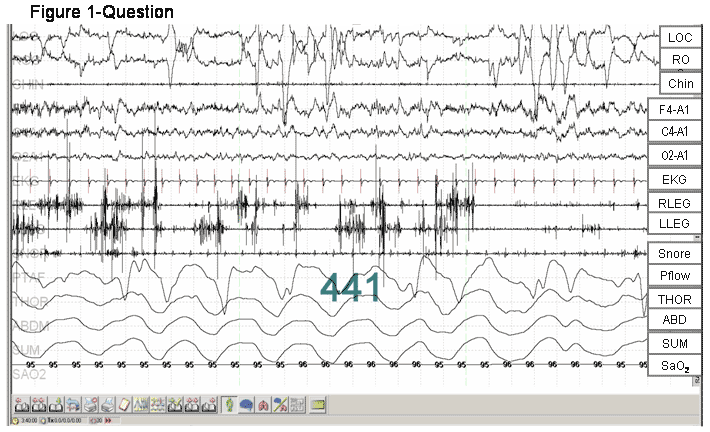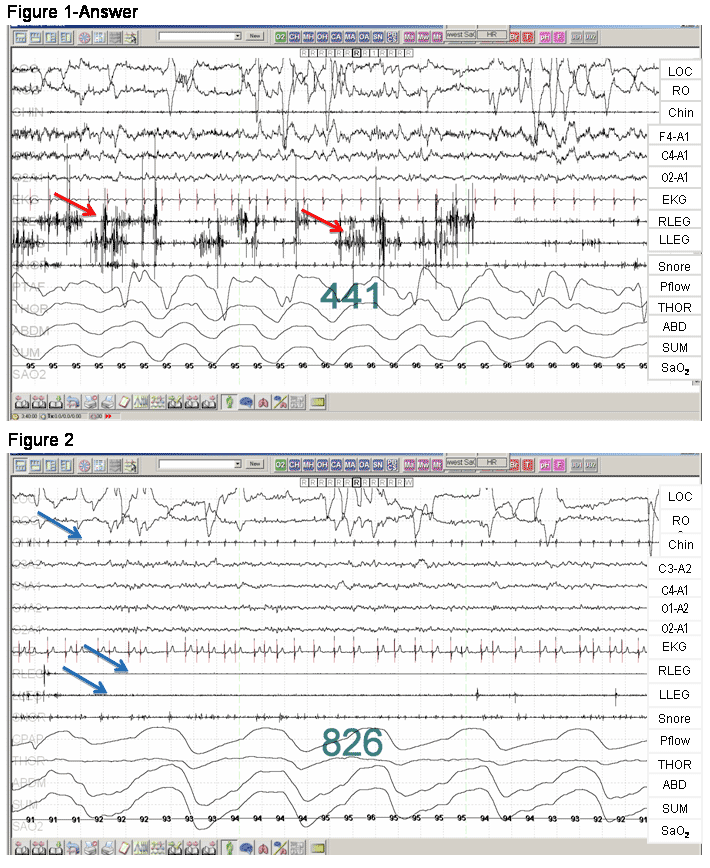Contributed by Prabhat Sinha, MD and Susmita Chowdhuri, MD. John D. Dingell VA Medical Center, Wayne State University
This is a 55 year old man with a history of snoring and frequent awakenings from sleep. The awakenings occur in the latter third of the night where he wakes up acting out dreams related to someone trying to ‘hurt his children’ and of an old burn injury.
Questions:
- What is the sleep stage?
- What is the diagnosis
- What is the sleep stage? Rapid eye movement (REM) sleep.
- What is the diagnosis? REM Sleep Behavior Disorder (RBD)
Discussion: By definition, REM sleep is characterized by low voltage mixed frequency EEG, rapid eye movements, and skeletal muscle atonia (figure 2, blue arrows show muscle atonia of chin and anterior tibialis EMG). However, in the PSG fragment shown (figure 1-answer), the 30 second epoch shows absence of REM atonia (loss of normal skeletal muscle atonia) as depicted by excessive phasic increases (red arrows) in the anterior tibialis EMG, occupying at least 50% of the duration of the epoch of REM sleep.
RBD is a parasomnia involving REM sleep and the motor system. As per the American Academy of Sleep Medicine 2007 scoring rules (1), the PSG findings in RBD are characterized by either or both of the following criteria:
- Sustained tonic activity in the chin EMG during REM: defined as an epoch of REM with at least 50% of duration with chin amplitude greater than the minimum amplitude in NREM.
- Excessive transient muscle activity during REM sleep in the chin or limb EMG: In a 30 sec epoch divided in 10 sequential 3 second mini-epochs, at least 5 (50%) of the mini epochs should have bursts of transient muscle activity. The bursts of transient activity are 0.1 to 5 sec in duration and at least 4 times as high as the back ground EMG activity.
In addition, time synchronized video PSG or a characteristic clinical history is necessary to make the diagnosis of RBD. Characteristic clinical history includes sleep related injurious or disruptive behavior. As a diagnostic tool, history alone has low sensitivity, hence PSG is required for diagnosis. Approximately, 87% affected are men with a mean age of onset at 60.9 years (2). Many of these patients are at risk for developing neurodegenerative disorders, specifically, alpha-synucleinopathies with dementia, including Parkinson’s disease, dementia with Lewy bodies and multi-system atrophy, about 10 years after the diagnosis of RBD. Clonazepam and adequate safety measures, to prevent injuries, are recommended for the management of RBD.
This patient had a history of acting out his dreams, as well as typical PSG findings of RBD. This particular fragment best illustrates the excessively increased phasic activity in limb EMG but without any sustained tonic activity in chin EMG.
References:
- The AASM Manual for the Scoring of Sleep and Associated Events. Westchester, IL: American Academy of Sleep Medicine, 2007.
- Rapid eye movement sleep behavior disorder: demographic, clinical and laboratory findings in 93 cases Olson et al, Brain, 123: 331-339, 2000.





